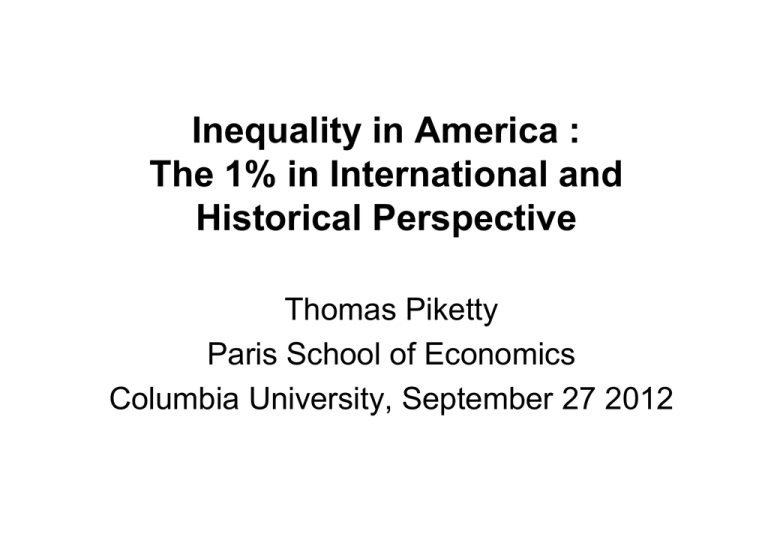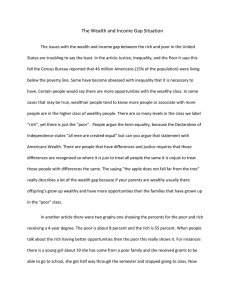Inequality in America : The 1% in International and Historical Perspective Thomas Piketty
advertisement

Inequality in America : The 1% in International and Historical Perspective Thomas Piketty Paris School of Economics Columbia University, September 27 2012 Inequality & capitalism in the long run • Long run distributional trends = key question asked by 19C economists • Many came with apocalyptic answers • Ricardo-Marx: a small group in society (land owners or capitalists) will capture an ever growing share of income & wealth → no “balanced development path” can occur • During 20C, a more optimistic consensus emerged: “growth is a rising tide that lifts all boats” (Kuznets 1953; cold war context) • But inequality ↑ since 1970s destroyed this fragile consensus (US 1976-2007: ≈60% of total growth was absorbed by top 1%) → 19C economists raised the right questions; we need to adress these questions again; we have no strong reason to believe in balanced development path • 2007-2012 world financial crisis also raised doubts about balanced devt path… will stock options & bonuses, or oil-rich countries, or China, or tax havens, absorb an ever growing share of world ressources in 21C capitalism? Convergence vs divergence • Convergence forces do exist: diffusion of knowledge btw countries (fostered by econ & fin integration) & wth countries (fostered by adequate educ institutions) • But divergence forces can be stronger: (1) When top earners set their own pay, there’s no limit to rent extraction → top income shares can diverge (2) The wealth accumulation process contains several divergence forces, especially with r > g → a lot depends on the net-of-tax global rate of return r on large diversified portfolios : if r=5%-6% in 2010-2050 (=what we observe in 1980-2010 for large Forbes fortunes, or Abu Dhabi sovereign fund, or Harvard endowment), then global wealth divergence is very likely This lecture: Inequality in America • Inequality in the US is now larger than ever before in American history. About 50% of national income goes to the top 10% (incl. 20% to top 1%), i.e. approximately the same record high level as UK or France around 1910. • Does US inequality keep a distinctive meritocratic character, or is the New World simply becoming like Old Europe ? • As compared to UK or France 1910, current US inequality has a different structure: it is more based upon labor income and less upon inherited wealth. But: • This difference is a matter of degree and should not be exagerated. US wealth concentration is very large. US wealthincome ratios might also reach record levels in the future. Key difference with Europe = population growth. • The enormous rise in top labor incomes has little to do with merit. Modern US inequality puts enormous pressure on loosers (meritocratic extremism). At least Belle Epoque or Ancien Régime inequality did not really pretend to be fair. 45% 40% 35% 30% 2007 2002 1997 1992 1987 1982 1977 1972 1967 1962 1957 1952 1947 1942 1937 1932 1927 1922 25% 1917 Share of total income going to Top 10% 50% FIGURE 1 The Top Decile Income Share in the United States, 1917-2010 Source: Piketty and Saez (2003), series updated to 2010. Income is defined as market income including realized capital gains (excludes government transfers). 45% Including capital gains Excluding capital gains 40% 35% 30% 2007 2002 1997 1992 1987 1982 1977 1972 1967 1962 1957 1952 1947 1942 1937 1932 1927 1922 25% 1917 Share of total income going to Top 10% 50% FIGURE 1 The Top Decile Income Share in the United States, 1917-2010 Source: Piketty and Saez (2003), series updated to 2010. Income is defined as market income including realized capital gains (excludes government transfers). 20% 15% 10% Top 1% (incomes above $352,000 in 2010) Top 5-1% (incomes between $150,000 and $352,000) Top 10-5% (incomes between $108,000 and $150,000) 5% FIGURE 2 Decomposing the Top Decile US Income Share into 3 Groups, 1913-2010 2008 2003 1998 1993 1988 1983 1978 1973 1968 1963 1958 1953 1948 1943 1938 1933 1928 1923 1918 0% 1913 Share of total income accruing to each group 25% Top Decile Income Shares 1910-2010 Share of total inc om e going to top 10% (inc l. realiz ed c apital gains 50% U.S. 45% U.K. Germany 40% France 35% 30% 25% 1910 1920 1930 1940 1950 1960 1970 1980 1990 2000 2010 Source: World Top Incomes Database, 2012. Missing values interpolated using top 5% and top 1% series. Top 1% share: English Speaking countries (U-shaped), 1910-2010 30 20 United States United Kingdom Canada Australia Ireland New Zealand 15 10 5 2010 2005 2000 1995 1990 1985 1980 1975 1970 1965 1960 1955 1950 1945 1940 1935 1930 1925 1920 1915 0 1910 Top Percentile Share (in percent) 25 Japan Sweden 2010 Switzerland 2005 Netherlands 2000 Germany 1995 France 1990 1985 1980 1975 1970 1965 20 1960 25 1955 1950 1945 1940 1935 1930 1925 1920 1915 1910 1905 1900 Top Percentile Share (in percent) Top 1% share: Continental Europe and Japan (L-shaped), 1900-2010 30 15 10 5 0 2010 2005 Italy 2000 Spain 1995 Germany 1990 France 1985 1980 1975 1970 1965 20 1960 25 1955 1950 1945 1940 1935 1930 1925 1920 1915 1910 1905 1900 Top Percentile Share (in percent) Top 1% share: Continental Europe, North vs South (L-shaped), 1900-2010 30 Sweden 15 10 5 0 US 2010 vs Old Europe 1910 • US income inequality in 2010 is as large as UK-France at the eve of World War 1: about 50% of national income goes to top 10% (incl. 20% to top 1%) • Does this imply that the structure of inequality is the same? Not necessarily. • In UK-France 1910, inequality was largely based upon inherited wealth: « rentier society » • In US 2010, inequality is more based upon labor income: « superstar society » • But this is a matter of degree: concentration of inherited wealth is currently very high in the US, and is rising • Main difference btw US and Europe: aggregate wealthincome larger in Europe, bc higher pop growth in US • Key mechanism: wealth-income ratio β = s/g If saving rate s=10% & growth rate g=3%, then β≈300% But if s=10% & g=1.5%, then β≈600% • Back in 1800, the US was already a country where wealth mattered much less than in Europe: abundant land is worth less, so that new world had more land in volume, but less land in value (more precisely: wealth mattered less in the US if we neglect slavery system; complex legacy for US inequality) 800% Private wealth / national income ratios 1870-2010 700% USA 600% Europe 500% 400% 300% 200% 100% 1870 1890 1910 1930 1950 1970 1990 2010 Authors' computations using country national accounts. Private wealth = non-financial assets + financial assets - financial liabilities (household & non-profit sectors) Private wealth / national income ratios in Europe, 1870-2010 800% 700% Germany 600% France 500% UK 400% 300% 200% 100% 1870 1890 1910 1930 1950 1970 1990 2010 Authors' computations using country national accounts. Private wealth = non-financial assets + financial assets - financial liabilities (household & non-profit sectors) National wealth in 1770-1810: Old vs New world 800% 700% Other domestic capital Housing Slaves Agricultural Land (% n a tio n a l in c o m e ) 600% 500% 400% 300% 200% 100% 0% UK France US South US North Why did US top labor incomes rise so much? • It is hard to account for observed cross-country variations with a purely technological, marginalproduct story: technical change also occurred in Europe & Japan, so why inequality ↑ in US only? • One popular view among some economists: US today = working rich get their marginal product (globalization, superstars) Europe today (& US 1970s) = market prices for high skills are distorted downwards (social norms, etc.) → very naïve view of the top end labor market… & very ideological: we have zero evidence on the marginal product of top executives; it could well be that prices are distorted upwards • A more realistic view: grabbing hand model = - marginal products are unobservable - top executives have an obvious incentive to convince shareholders & subordinates that they are worth a lot - no market convergence because constantly changing corporate & job structure (+ costs of experimentation → competition failure) → when pay setters set their own pay, there’s no limit to rent extraction... unless confiscatory tax rates at the very top (memo: US top tax rate (1m$+) 1932-1980 = 82%) Top Income Tax Rates 1910-2010 100% Top m arginal inc om e tax rate apply ing to top inc om e 90% 80% 70% 60% 50% 40% U.S. 30% U.K. 20% Germany 10% France 0% 1910 1920 1930 1940 1950 1960 1970 1980 1990 2000 2010 Source: World Top Incomes Database, 2012. • Explaining long run changes in inequality requires looking at political and cultural change • As a country, the US has been « playing yo-yo » with the rich over the 20th century: - In the 1920s-1970s, the US invented steeply progressive income and estate taxation. One objective was to avoid the excessive wealth concentration associated to Europe. - In the 1970s-2010s, the US dismantled progressive taxation. One objective was to renew with govt-free 19c US. « America is back ». Catch-up by Europe/Japan. • Pb: US growth 1980-2010 is not better than US growth 1950-1980 or Europe growth 1980-2010 • Extreme concentration of labor rewards does not seem to be the best way to organize 21c skill based economy Summing up • American inequality will keep its distinctive character as long as the US remains the New world, i.e. as long as population growth is much larger than Europe • … and if the US renews with its equal-opportunity tradition and institutions: massive investment in skills, progressive taxation to prevent excessive concentration of wealth and economic power • Otherwise the US inequality model can become the worst of all worlds: large concentration of wealth + large concentration of labor income + extremist meritocratic discourse putting pressure on loosers Top Inheritance Tax Rates 1900-2011 100% 90% U.S. 80% U.K. 70% France 60% Germany 50% 40% 30% 20% 10% 0% 1900 1910 1920 1930 1940 1950 1960 1970 1980 1990 2000 2010 Private wealth / national income ratios, 1970-2010 800% 700% 600% USA Japan Germany France UK Italy Canada Australia 500% 400% 300% 200% 100% 1970 1975 1980 1985 1990 1995 2000 2005 2010 Authors' computations using country national accounts. Private wealth = non-financial assets + financial assets - financial liabilities (household & non-profit sectors) Private wealth / national income ratios, 1970-2010 (incl. Spain) 800% 700% USA Japan Germany France UK Italy Canada Spain Australia 600% 500% 400% 300% 200% 100% 1970 1975 1980 1985 1990 1995 2000 2005 2010 Authors' computations using country national accounts. Private wealth = non-financial assets + financial assets - financial liabilities (household & non-profit sectors) 800% 700% 600% Private vs governement wealth, 1970-2010 (% national income) USA Japan Germany France UK Italy Canada Australia 500% 400% 300% Private wealth 200% Government wealth 100% 0% -100% 1970 1975 1980 1985 1990 1995 2000 2005 2010 Authors' computations using country national accounts. Government wealth = non-financial assets + financial assets - financial liabilities (govt sector) 800% The changing nature of national wealth, UK 1700-2010 700% Net foreign assets Other domestic capital (% national income) 600% Housing Agricultural land 500% 400% 300% 200% 100% 0% 1700 1750 1810 1850 1880 1910 1920 1950 1970 1990 2010 National wealth = agricultural land + housing + other domestic capital goods + net foreign assets The changing nature of national wealth, France 1700-2010 800% 700% Net foreign assets Other domestic capital (% national income) 600% Housing Agricultural land 500% 400% 300% 200% 100% 0% 1700 1750 1780 1810 1850 1880 1910 1920 1950 1970 1990 National wealth = agricultural land + housing + other domestic capital goods + net foreign assets 2010 The changing nature of national wealth, US 1770-2010 600% (% national income) 500% Net foreign assets Other domestic capital Housing Agricultural land 400% 300% 200% 100% 0% 1770 1810 1850 1880 1910 1920 1930 1950 1970 1990 2010 National wealth = agricultural land + housing + other domestic capital goods + net foreign assets 600% The changing nature of national wealth, US 1770-2010 (incl. slaves) Net foreign assets Other domestic capital Housing Slaves Agricultural land (% national income) 500% 400% 300% 200% 100% 0% 1770 1810 1850 1880 1910 1920 1930 1950 1970 1990 National wealth = agricultural land + housing + other domestic capital goods + net foreign assets 2010 The changing nature of national wealth, Canada 1860-2010 600% Net foreign liabilities Other domestic capital Housing Agricultural land (% national income) 500% 400% 300% 200% 100% 0% 1860 1880 1900 1920 1940 1960 1980 2000 National wealth = agricultural land + housing + other domestic capital - net foreign liabilites









